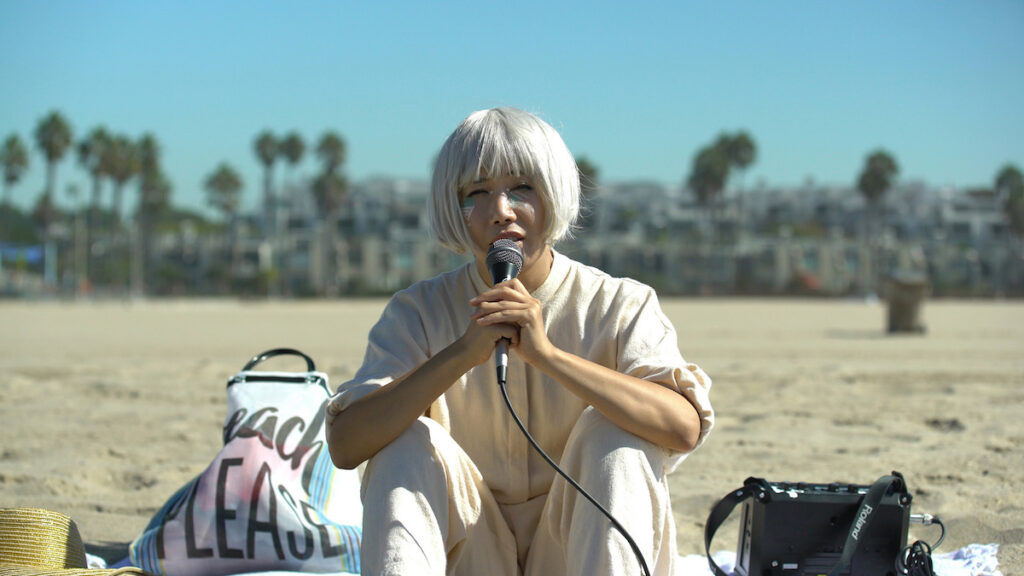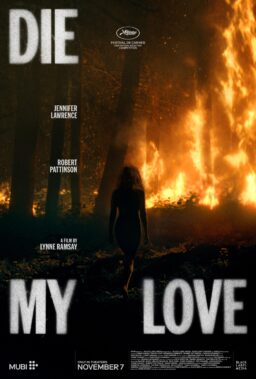Daryl Wein’s “Lola Versus” had the clear objective of propelling the career of a budding actress named Greta Gerwig further into the film world. At this year’s Sundance, Wein attempts the same with Korean-American artist Vivian Bang. Wein and Bang have co-written a story that essentially introduces her to the world, to the tune of her own fanfare but welcoming us to join. “White Rabbit,” which premiered today as part of the forward-thinking NEXT competition, has the kind of career-making performance that gets you to know a fresh performer so well, but it also leaves a great impression of her potential. And if Bang is allowed to build on this showcase in future projects, the film scene will be better and all the more original for it.
With Wein confirming during the World Premiere introduction that the movie is inspired by her work in real life, the movie starts with Bang making her original art: standing in the middle of a corporate grocery store in a blonde wig and white jumpsuit, talking into a microphone and portable speaker using an exaggerated accent. She is creating art that is very much her, and while she does not interact with people in this place or during other occasions, Bang is heard as she successfully occupies the space. It makes for a striking visual, similar to when she presses her face into piles of food in front of her iPhone camera, to later be uploaded to YouTube. But as she later tells her mother, who thinks that she’s a sculptor, “It’s not art that people can buy.”
Unabashed creative expression is just one compelling facet of Bang, who creates a full character throughout “White Rabbit”’s 71-minute running time, which consists mostly of Wein’s albeit standard cinematic vision filming her character, Sophia, conversing with other women of color but being 100% herself. She meets Victoria Ghana (Nana Ghana), who turns out to be a photographer with similar perspectives on being a “hyphen American,” but they also take genuine interest in each other. Ghana too makes a strong impression in a role that becomes more complicated as Sophia has feelings but Victoria may not, portraying someone who is less lonely than Sophia.
But the movie is certainly Bang’s moment to shine, taking on moments that are curious (smashing her face into a pile of Cheetos, and then studying herself in the phone) and comedic (an angry conversation, with microphone in hand) with zeal. The script that Wein and Bang have written doesn’t always seem to take advantage of her abilities (and there’s an emotional conversation with an ex-girlfriend that feels forced) but that does leave the viewer wanting more.
Within the triumphant progressiveness of “White Rabbit” there is also a degree of preachiness that might divide viewers. But even in the way that Sophia speaks into a microphone with a mini-speaker, “White Rabbit” owns this attitude, and creates an immediacy to it. This is the rare movie that feels like it comes from 2018, where people are talking daily about racial tension and various facets of identity. With credit to the script, the movie is funny about this in some cases too, like when the white Wein takes a shot at his own storytelling process by having Sophia interact with a director who wants to cast her for just a few lines, and with the accent. A walking embodiment of white guilt, the director fetishizes her “struggle” as a Korean-American, and shows a counterproductive brand of woke-ness. But even when touching about these ideas, the movie is more than its lead’s race, talking about these things initially so that other ideas can be brought to the forefront, such as Vivian’s artistry, or her difficulty with women.
In a way that in part makes me like Sundance just a little bit more, there are huge landmarks that happen in this movie. Women of color speak extensively about much more than their gender or their race, and are given space to become complicated, funny, to be creative and to be weird. A lot of what happens in “White Rabbit” should not have to be considered a headline, but with filmmaking’s clear deficit of perspectives, it is. But here’s a much more joyous headline: Vivian Bang is a Star.

I was not aware there were so many artistic Elliotts until I went to Sundance. Meaning, the family of comedian Chris Elliott, from the likes of “Kingpin,” is much more than his familiar face now: it’s burgeoning writer/director Bridey Elliott, former “Saturday Night Live” cast member Abby Elliott, and mother of the house, Paula Niedert Elliott, previously with no acting credit. For her directorial debut, Bridey Elliott writes about what she knows: that she has a funny, raucous family, and that her mother has been relatively out of the spotlight, until now.
Like a family-cast mumblecore movie with tinges of horror, “Clara’s Ghost” focuses on the Elliotts, starting with her parents. In this case, they are known as the Reynolds, but Chris Elliott’s character is now named Ted, and is alluded to have some type of noteworthy acting career at some point. Clara (played by Paula Niedert Elliott), has taken a more domestic role in the house, always cleaning after. At the beginning of the movie, she’s already a shade of Gena Rowlands in “A Woman Under the Influence,” pleading to cops to help her find a lost shoe. But in a more direct way, something is off with Clara, as she sees visions of a woman who lived in their old Connecticut house years ago. Sometimes the score clues us into an emerging creepiness, and that often involves the mystery woman getting closer and closer each time Clara sees her.
Writer/director Bridey and sister Abby show up soon enough as two sisters, this time with a juvenile show in their past (an interesting fictional addition to a story that likes to dabble in reality). They’re both actors in different places in their careers, facing the jealousy from their father who just got kicked off a production (for being an asshole, nonetheless). This leads to a type of tension that plays throughout the night as the family drinks a lot, while minimizing the presence of a wacked-out Clara. In this instance, whether the script is trying to be funny or taking a slow-burn psychological route, the movie operates with the flat idea of an outcast family member, and doesn’t build upon it so much as tease it. Sometimes it seems like something wild is about to happen, and in other instances its the ho-hum of a random flower pot almost falling on someone’s head.
“Clara’s Ghost” has the unique appeal of being an all-out family affair, and we get to see the Elliotts do it all, often to the detriment of a 90-minute running time. They laugh, they sing, they dance, they make pussy jokes and drink a lot. Elliott creates a free flowing atmosphere but having a likable cast only fills the space so much; instead of picking up speed, “Clara’s Ghost” more often feels directionless and tedious. Even the various moments that are given to Paula Neidert Elliott to perform are amusing more than captivating, and overstay their welcome. And as the story makes her at first frightened and then strange, the script dissolves into weak bits of shock laughter.
Just as the movie is fueled by its personal nature, so does it seem to strictly come from Elliott’s taste and interests, of which your alignment may vary. It greatly depends on how much you enjoy spending time with her family, if you find their off-hand banter funny and their meta references to being Elliotts interesting. It also depends on what you want out of movies that have some inkling of horror. With either of these genre elements, to her credit, she plays by her own rules. But I found neither the family comedy or the ghostly ingredients to be particularly potent, and whenever they did get blended it didn’t make for a strong mix.












